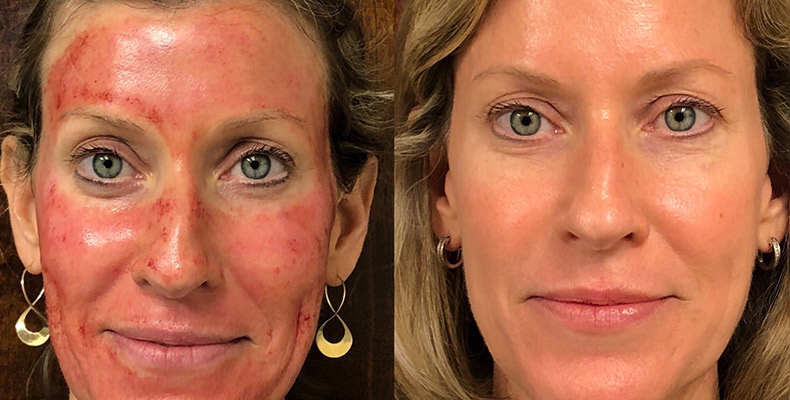Eczema is a skin condition that affects more than 30 million Americans. Here at Columbia Skin Clinic, we aim to provide helpful information about eczema and atopic dermatitis to our patients. Here, we break down what these skin conditions are and how you can treat them.
What is eczema?
Eczema is a non-contagious group of skin conditions that are characterized by itchy, inflamed, red patches on the skin. Children often start to show signs of eczema during their first six months of life. Eczema patches typically appear on the cheeks, arms and legs, especially the backs of the legs. Eczema patches tend to flare-up, then disappear, then come back again.
What are the various types of eczema?
There are numerous types of eczema, including atopic dermatitis, contact dermatitis, nummular eczema, dyshidrotic eczema, stasis dermatitis, seborrheic dermatitis, neurodermatitis, perioral dermatitis and dermatitis herpetiformis. All eczema types can cause redness and itching, and some individuals will even blister or peel. Causes and symptoms vary by type.
Atopic dermatitis is the most common form of eczema, affecting nearly 20% of children and 3% of adults. This article will focus primarily on atopic dermatitis.
What is atopic dermatitis?
Atopic dermatitis or AD is a form of eczema most commonly found in children and is rare in adults. The American Academy of Dermatology Association says that 90% of people who suffer from atopic dermatitis get it before the age of five. About 50% of people who suffer from AD during childhood continue to have milder signs and symptoms in adulthood. Even adults who had AD as children but who no longer have eczema can still suffer from extremely dry, irritated skin and hand eczema.
What is the difference between atopic dermatitis and other forms of eczema?
Atopic dermatitis is often used interchangeably with the term eczema, but all forms of eczema have different triggers. Atopic dermatitis is a harsher form that mainly forms in children.
People living with AD can experience many different sensitivities for the duration of their life. Their skin will be dry and easily irritated. Those who suffer from AD are also at a higher risk for eye issues such as eyelid dermatitis or cataracts.
It is important to understand what type of eczema you or your child have so you can manage and treat it in the best way possible. The only way to be sure of this condition is to see a dermatologist.
What are the symptoms of atopic dermatitis?
Atopic dermatitis is considered a severe and/or long-lasting form of eczema. Symptoms may vary by individual and also in children vs. adults. When a young child or baby begins to experience symptoms, he or she often experiences an itchy, scaly rash in the creases of the knees and elbows. AD will also appear on the scalp and face, especially the cheeks. Symptoms of AD during infancy or childhood include the following:
- Dry, scaly, itchy patches
- Patches that blister and ooze fluid
- Itching that comes and goes
- Bumpy skin that looks like permanent goosebumps
- Lighter or darker skin where the AD appears
- Thickening of the skin to protect against scratching
Adults with AD usually have different symptoms, often more severe. Atopic dermatitis appears in the creases of the elbows or knees and the nape of the neck and can cover a large portion of the body. Symptoms in adults include:
- Patches around the eyes
- Extremely dry skin all over
- Non-stop itching
- Skin infections
What causes atopic dermatitis?
While studies show that AD has become more common now than 30 years ago, the exact cause is difficult to pinpoint. Hypersensitivity to certain foods, allergens or environmental factors is thought to cause symptoms in children. Furthermore, if a parent or family member has atopic dermatitis, hay fever or asthma, a child has a 50% chance of developing one of those conditions.
How do you treat atopic dermatitis?
There is no cure for any of the forms of eczema, including atopic dermatitis; however, there are ways to manage the condition.
- Monitor closely to determine your skin’s triggers and try your best to avoid them.
- Keep skin moisturized and follow a healthy skin care regime.
- Apply heavy skin cream and ointment that contains little water immediately after a shower or bath while your skin is still wet.
- A dermatologist may prescribe medications to treat symptoms. These may include steroid ointments or creams for mild flare-ups or an oral steroid pill for more severe cases.
Treatment for eczema in Columbia and The Midlands
If you think you or your child is experiencing any of the above symptoms, see a dermatologist immediately. Our board-certified dermatologists at Columbia Skin Clinic offer treatment and support for patients dealing with all types of skin conditions. Book an appointment online today at one of our four dermatology offices in the Columbia region.







